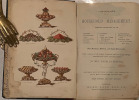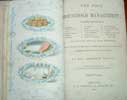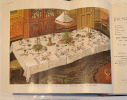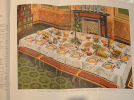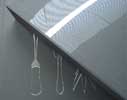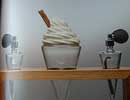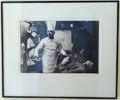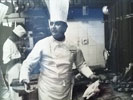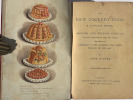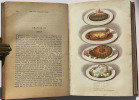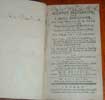Beeton.
Isabella Mary
- The original 24 monthly parts.
The Book of Household Management.
Comprising information for the MISTRESS, HOUSEKEEPER, COOK, KITCHEN-MAID, BUTLER, FOOTMAN, COACHMAN, VALET, UPPER AND UNDER HOUSE-MAIDS, LADY'S MAID, MAID-OF-ALL-WORK, LAUNDRY-MAID, NURSE AND NURSE-MAID, MONTHLY, WET AND SICK NURSES, ETC.ETC. ALSO SANITARY, MEDICAL AND LEGAL MEMORANDA; WITH A HISTORY OF THE ORIGIN, PROPERTIES, AND USES OF ALL THINGS CONNECTED WITH HOME LIFE AND COMFORT. BY MRS ISABELLA BEETON. "Nothing lovelier can be found in woman, than to study household good".-Milton. LONDON: S.O. BEETON, 248, STRAND, W.C. 1861.
FIRST and SOLE EDITION, in the original 24 parts. 8vo. As called for, parts 1 & 2 in creamy beige paper covers printed in black; Parts 3 - 24 in terra cotta paper covers printed in black. There are 12 coloured plates as frontispieces to parts 1-10 & parts 13 and 16. Part 1 has the printed title page, with the Bouverie St. address. Frontispiece of the “The free, fair homes of England”. The Title page, 2p Preface, the General Contents and first 2pages of the Analytical Index mis-bound into booklet 24, but all present and correct. Booklet # xii mis-printed as # vii, but collation is correct. All with the original printed wrappers and with a few very minor scuffs otherwise the whole set complete and in very good condition. All the pages untrimmed and some uncut. Housed in a handsome modern clamshell box with half bottle green morocco and cloth boards. Spine with raised bands, gilt lines and two red calf labels with gilt writing and tooling.
-
Isabella Beeton accomplished an amazing amount during her short life. The early deaths of her first and second-born children must have been devastating, yet she quickly resumed work at her usual furious pace. In an era when middle class females were expected to have no interests beyond "womanly matters", Isabella came to excel at a man's job in the manly profession of journalism. She could not have done so without the encouragement of her husband Sam, a London publisher of books and magazines for the newly prosperous middle class.
Isabella and Sam complimented one another superbly on both a personal and professional level. Sam was emotional and creative, a genius at marketing his publications. Isabella was reserved and level headed, a meticulous researcher. Both were tireless workers in spite of the tuberculosis that eventually caused Sam’s death 12 years after Isabella's. Soon after their 1856 marriage Isabella began writing cookery articles for Sam's ‘Englishwoman's Domestic Magazine’ (EDM), that were issued in monthly booklets and also an annual volume. In time she also became the editor. Later came editorial responsibilities for the Beeton’s newly created magazine ‘The Queen’, but not before she had completed her research for the magnificent work for which she is still known today.
‘Household Management’ evolved from the cookery columns Isabella wrote for EDM. Her first few articles were written somewhat tentatively, for she had no previous culinary experience except pastry-making lessons at a boarding school in Germany. In spite of this she soon perfected her research methods and smooth confident style of writing. By the end of their first year of marriage Sam and Isabella had made plans to publish ‘Beeton's Book of Household Management’.
‘Household Management’ debuted firstly in EDM, then the first booklet was published November 1st 1859 and subsequently in a total of 24 monthly instalments, although in the first booklet it states that it was designed to be completed in 15 to 18 parts. Isabella had started testing recipes as early as 1857. Recipes found too difficult or expensive for the middle class households for which Isabella was writing (with the exception of an extravagant Louis Eustache Ude recipe for Turtle Soup), were discarded. Many of the final selections came from Eliza Acton's ‘Modern Cookery for Private Families’, and from Alexis Soyer's ‘Modern Housewife’, and other undisclosed sources.
Isabella's skill was editing, not cookery, and she made no claim of composing any of the recipes herself except a "Soup for Benevolent Purposes". In the extensive advertising at the back of the first booklet it states that --- “the Editoress had nearly 2000 ladies of Great Britain and Ireland placed, and continue to place at her disposal, their assistance in furnishing such a collection of ‘facts’ relative to Domestic Economy, as had never before been brought together to enrich the pages of any similar work”. It further states that – “no recipe will be given that has not been tested by the Editoress or by her confidential friends and correspondents”. Many of those helpers no doubt scoured the popular cookery books of the time, to test, taste and send their results to Isabella. In these days of instant e-mail, Skype, mobile phone or working web-sites, for Isabella to manage, in the 1850’s, the correspondence and communication by letter of those 2000 recipe testers and helpers brings these booklets into a new light.
These 24 parts are mainly about cookery, but there is also a chapter with instructions to the mistress of the house regarding responsibilities and duties, plus a detailed chapter on managing servants, including recipes for various household preparations. Three of the book's chapters, two medical and one legal, were not written by Isabella, but the inclusion of the legal chapter is noteworthy given the poor legal status of women during the Victorian era.
‘Household Management’ sold steadily in the original parts, and in 1861 the 24 parts were issued as the first edition in book form. As the last booklet was published in November 1861 the publication of the book by the end of that year was accomplished very efficiently.
The only real differences between the parts and the first edition in book form is the absence of the covers of the booklets and the absence of the substantial advertising inside and on the covers. Interestingly, the title page and the page with the list of the coloured plates is the last page of the last booklet (# xxiv) but are in the right order given for the first edition in book form. The surprise is the plates are the frontispieces in the booklets and not in the order stated in the list of coloured plates. This shows that Isabella was getting the book ready for the printer long before the last booklet appeared and the title page and colour plate list inserted in booklet 24 appear to be a curious afterthought proving that unlike other books whose title pages are among the first to be printed, she by necessity had to have them printed for the book last. As the booklets were sold separately by the month and are quite delicate within their paper covers, then complete and undamaged sets are extremely rare. These are the original parts of the biggest publishing phenomenon of the 19th century.



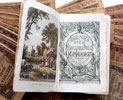


|
|

Antiquarian category
ref number:
11175
|

